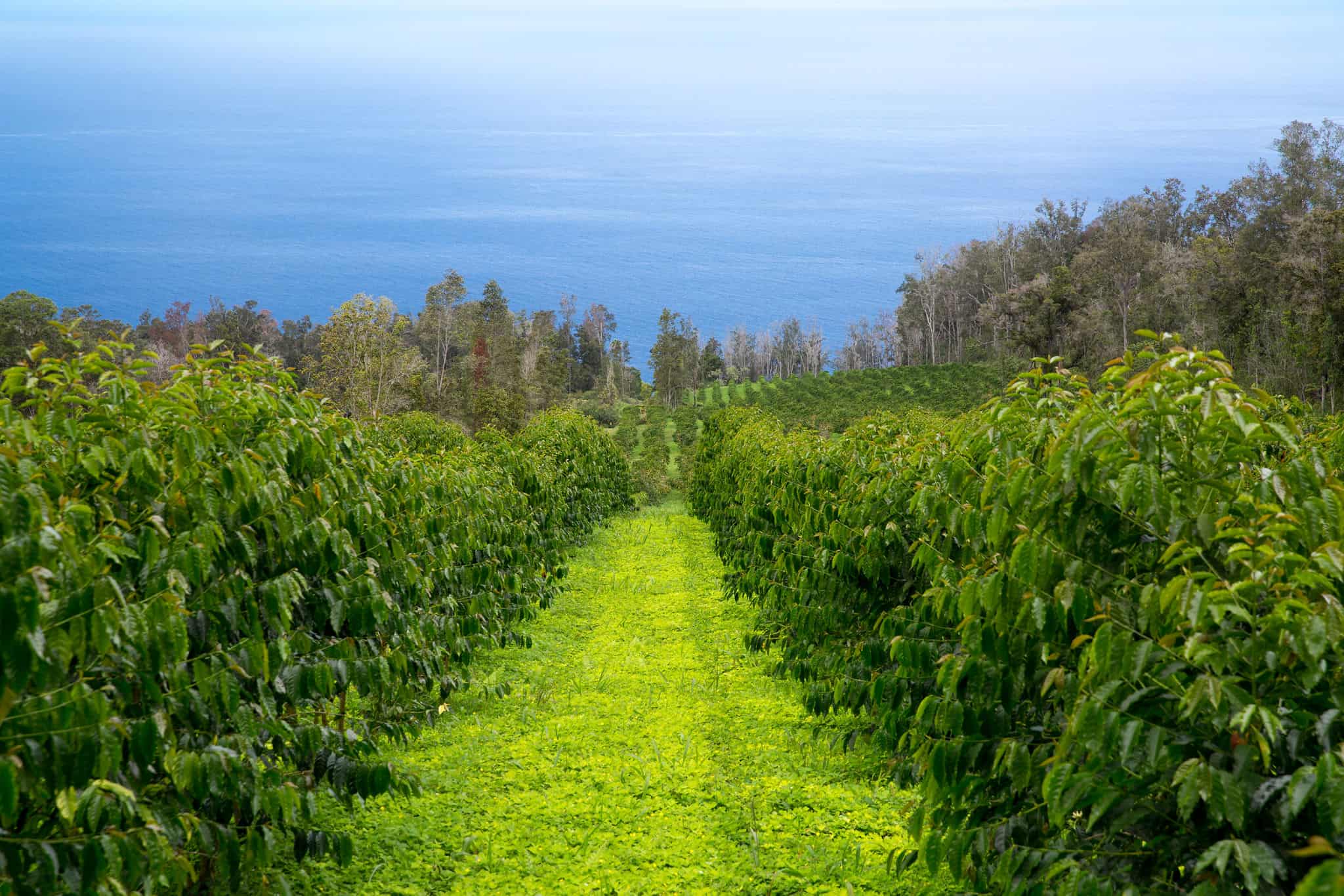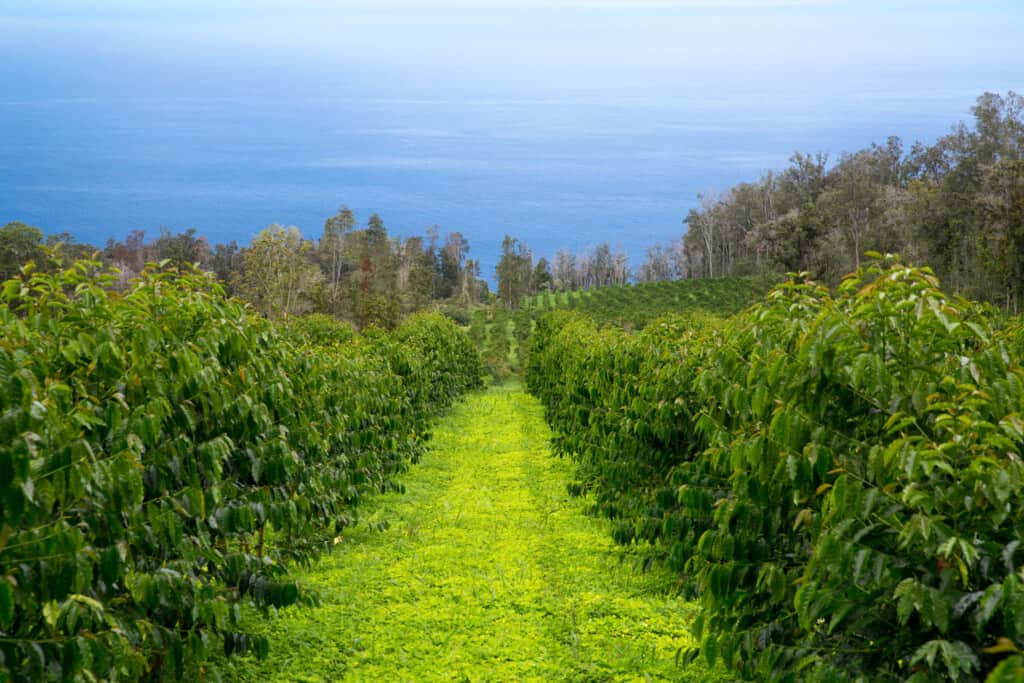
A view of the Pacific Ocean from Hala Tree’s espresso farm in Captain Cook dinner, Hawai’i. Courtesy of Hala Tree.
When most of us consider Hawaiʻi, we consider good seashores, iconic sunsets and unparalleled rest. When espresso lovers consider Hawaiʻi, “Kona” is usually the primary phrase that involves thoughts. However whereas the Hawaiian Islands are, certainly, a paradise, they’re additionally a spot the place espresso is a essential a part of the financial system — an financial system that’s been hammered over the previous few years by the Covid-19 pandemic and by devastating wildfires, to not point out agricultural pests and illnesses particular to the espresso trade.
This month, we not solely check out the islands’ coffees — roasted by locals — we additionally scope out what residents, most of whom can’t afford to purchase Hawaiʻi-grown espresso for each day consuming — prefer to have of their morning cup.
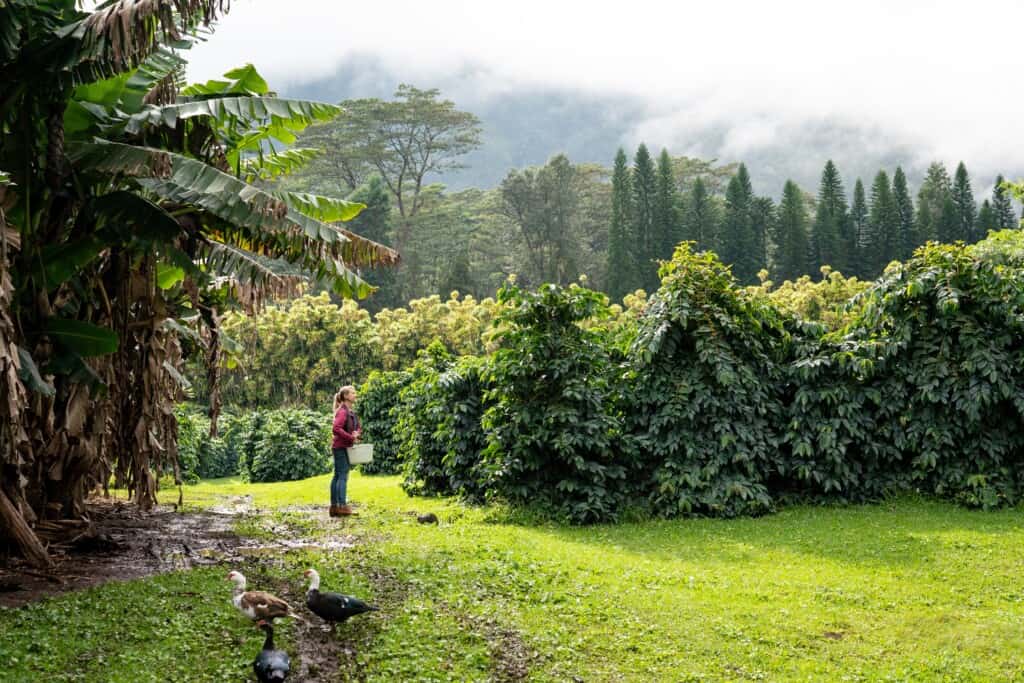
Brandon von Damitz of Huge Island Espresso Roasters surveying espresso timber at Silver Cloud Farm. Courtesy of Braden Tavelli.
There are three important sorts of Hawaiian espresso roasters: espresso farmers who roast their very own inexperienced coffees, roasters that promote solely Hawaiian-grown coffees (largely to a global market), and roasters that promote each Hawaiian coffees and coffees from different origins.
The Present Context of Espresso in Hawaiʻi
Whereas Hawaiʻi contributes solely 0.04 p.c of the world’s espresso manufacturing, espresso is the second most worthwhile crop grown within the state, an in depth second to macadamia nuts (School of Tropical Agriculture and Human Sources, College of Hawai’i at Manoa). A lot of the espresso grown within the state is exported. Throughout the 2022–23 harvest season, Hawaiʻi farmers produced 24.8 million kilos of espresso, down 9 p.c from the earlier yr (USDA). One of many chief causes manufacturing is down is the emergence of espresso leaf rust (CLR), a fungal illness that has devastated whole espresso industries elsewhere on the planet. It first appeared on Maui in 2020, then a number of weeks afterward Hawaiʻi Island, often known as the Huge Island, which produces the overwhelming majority of the state’s espresso crop. (For reference, the Huge Island has greater than 1,400 espresso farms, whereas Maui has simply over 300, Kauaʻi has three, and O’ahu and Molokai every have one.)
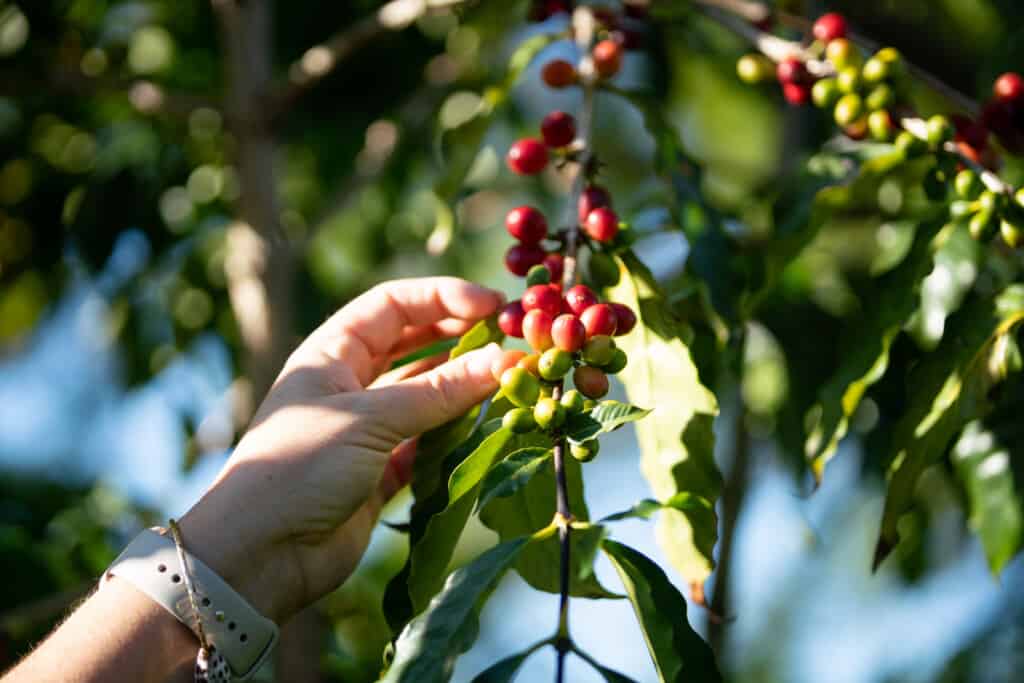
Espresso cherries ripening on Monarch Espresso Farm in Kona, Hawai’i. Courtesy of Monarch Farm.
Earlier than CLR, espresso berry borer (CBB) was the most important menace to the state’s espresso crop. CBB was present in Kona in 2010, O’ahu in 2014, Maui in 2016, and Kauaʻi and Lānaʻi in 2020 (School of Tropical Agriculture and Human Sources, College of Hawai’i at Manoa) . This beetle, endemic to Central Africa, was accountable for decimating nearly all of Maui’s small crop that yr. Administration methods are actually in place to considerably curb its potential for destruction, but it surely stays a power.
Lastly, there have been a number of wildfires in 2023, and the unprecedented scale of the fireplace that destroyed the city of Lahaina, Maui, has affected the state’s financial system total, each when it comes to its largest trade, tourism, and when it comes to the lack of dozens of coffee-related companies. Maui Grown Espresso, the island’s largest producer, has not but resumed operations, and plenty of espresso outlets had been destroyed or displaced.
Certainly one of Hawaiʻi’s strengths as a producing area is that its espresso costs usually are not, as they’re in most origins, tied to the commodity espresso market. Within the Nineteen Eighties, Kona’s rising star and the advertising brilliance behind it allowed the area to promote its coffees for a lot larger costs than every other origin. At the moment, the common value of unroasted Kona espresso is $26.50 per pound, whereas the common value for Arabica espresso is $2.03 per pound. So, why aren’t Hawaiian espresso farmers paving their driveways with gold? Two easy solutions: Yield is down, and prices are larger than anyplace else on the planet the place espresso is grown.
We overview many Hawaiʻi-grown coffees annually, however this report seems to be on the state’s present espresso scene from a broader perspective, as we invited roasters based mostly anyplace in Hawaiʻi to ship us samples from any origin. We obtained 45 samples: 31 roasted on Hawaiʻi Island, seven on O’ahu, three from Maui, and 4 from Kauaʻi.
We overview right here the 14 top-scoring coffees, 11 Hawaiʻi-grown and three grown elsewhere.
Hawaiian Farmers Roasting Their Personal Inexperienced Coffees
There’s a protracted native historical past of espresso farmers roasting up small batches of their coffees to promote at farmers markets and farm stands, however these are, by and huge, not the perfect illustration of those coffees. Farmers usually are not usually skilled roasters. There are some notable exceptions to this rule, and we cupped six coffees from roasters who’re additionally farmers, and who paid exact consideration to each side of the operation.
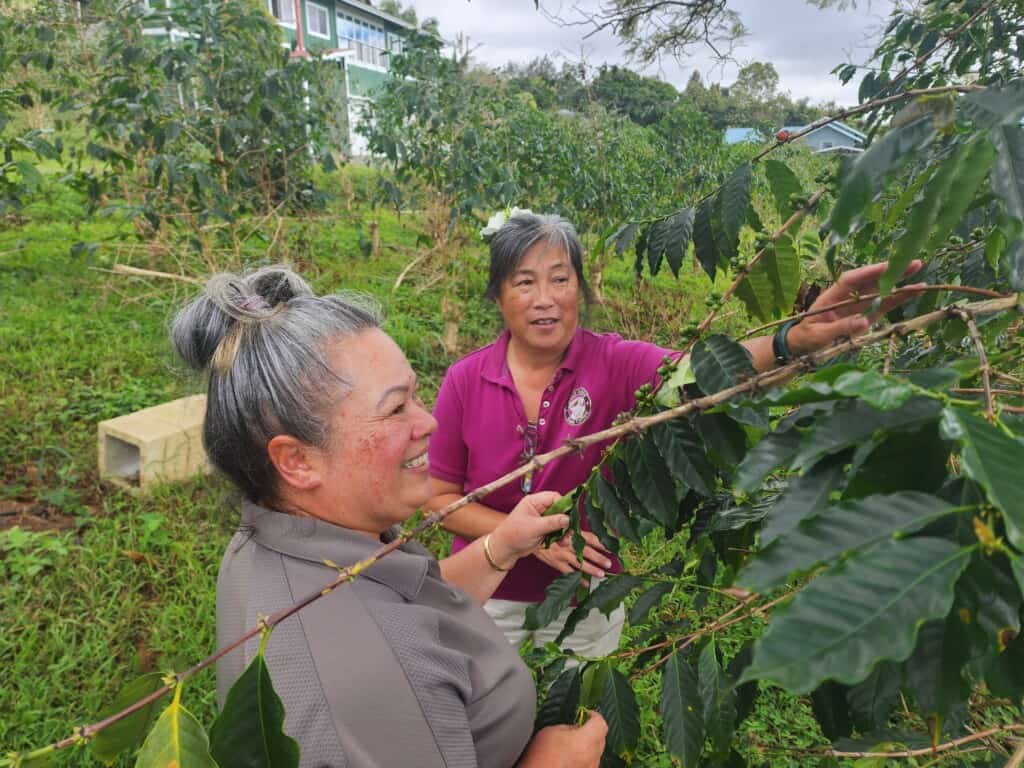
Laura Ross (left), roaster, and Karen Paterson, co-owner of Hula Daddy Kona Espresso. Courtesy of Hula Daddy.
The best-scoring espresso on this report was Hula Daddy’s wildly spectacular Laura’s Reserve SL34 (97), produced on the firm’s farm in Holualoa (North Kona) and roasted by Laura Ross, who’s been with Hula Daddy for greater than a decade. Co-owner Karen Paterson, who based Hula Daddy along with her husband, Lee, in 2002, says, “The foremost problem of rising espresso in Hawaiʻi is labor prices. With advantages, our common hourly pay is over $25. A Central American grower pays staff lower than $2 an hour performing the identical work, and labor charges in African international locations are round $20 a month.” Hula Daddy sells solely retail-roasted espresso (versus inexperienced espresso or wholesale), each onsite and on-line, all completely from the Patersons’ personal 10-acre farm. Its major clients are shopping for espresso for house use, and solely 10 p.c reside in Hawaiʻi. The SL34 is an aromatically intoxicating Kona model of a wide range of Arabica historically grown in Kenya and is exuberantly complicated.

Kraig Lee of Kona Farm Direct raking coffees drying on a concrete patio. Courtesy of Kona Farm Direct.
Kraig and Leslie Lee of Kona Farm Direct have been rising conventional Kona espresso for greater than 25 years. Prior to now eight years, they’ve begun experimenting with new varieties, together with Geisha. Kraig Lee says, “Little doubt, the distinctive Kona soil and setting can produce among the highest quality coffees on the planet, however there are dozens of the way you’ll be able to screw it up. For those who don’t take note of the main points, you’ll be able to flip nice espresso into common or worse. I’m so lucky that I’ve workers who satisfaction themselves in caring for the land, selecting solely ripe cherries, and correctly processing and drying the beans.” Kona Farm Direct’s 100% Kona Traditional (94) is a vigorous, balanced Typica, sweet-toned, chocolaty and wealthy.

Lorie Obra, co-founder of Rusty’s Hawaiian in Pahala Hawai’i. Courtesy of Rusty’s.
Rusty’s Hawaiian is one other longtime household farm, based mostly within the Ka‘ū rising area on the east aspect of Hawaiʻi Island south of Hilo. Based by Rusty and Lorie Obra within the late Nineteen Nineties, Rusty’s was on the cusp of creating a reputation for Ka‘ū espresso, a area within the shadow of Kona. When Rusty died of most cancers in 2006, Lorie dedicated to actualizing their dream, and Rusty’s, now a world-class roaster as nicely, put Ka‘ū on the map. Rusty’s Traditional Ka‘ū Peaberry (94) is lush, decadently candy, deep-toned and sensuous. Lorie’s daughter, Joan, and son-in-law, Ralph Gaston, moved from the mainland to Pahala (the place Rusty’s is situated) full-time in 2011, and the couple run the operation with Lorie, who’s nonetheless going sturdy in her seventies. Gaston says that there are lots of challenges concerned in farming espresso in Hawaiʻi: “The elevated price of manufacturing, primarily because of the unfold of espresso leaf rust, has been troublesome to take care of. This implies extra for remedy of CLR, managing that with the remedy for espresso borer, elevated prices for fertilizer, to not point out rising labor prices. It’s plenty of strain on the price of manufacturing.” A full 40 p.c of Rusty’s on-line clients are based mostly in Hawaiʻi, and the remaining 60 p.c are from the West Coast (California, Oregon, Washington) and Alaska, with a small proportion in Canada, Japan, Germany and Korea.
Kona’s Heavenly Hawaiian is one in every of a number of Hawaiian farmer-roasters working with non-traditional kinds of Arabica. The Kona Geisha Champagne (94) submitted for this report has elegant notes of nectarine, star jasmine and cocoa nib, a profile similar to the normal Geishas of Panama.
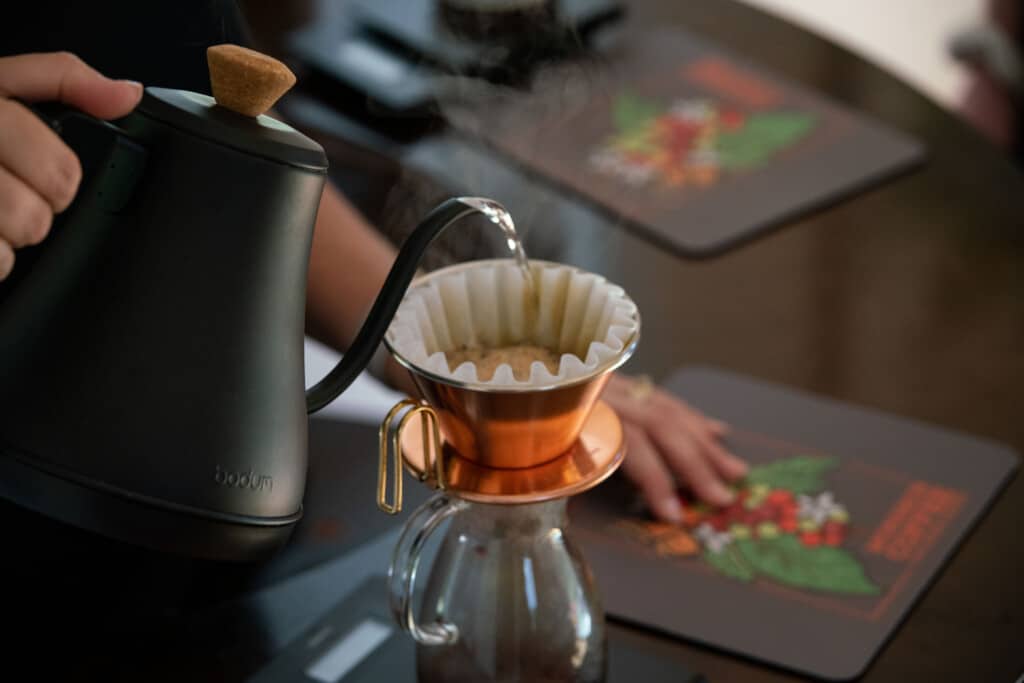
Brewing a pour-over at Monarch Espresso Farm in Kona, Hawai’i. Courtesy of Monarch Espresso.
Monarch Espresso’s “Hapa” (which means “half”) (93) is a post-roast mélange of light-, medium- and dark-roasted Kona Typica, a comfortingly acquainted Kona profile that’s crisply chocolaty and sweetly nutty. Abby Munoz, director of operations and daughter of co-founders Greg and Susy Stille, describes Monarch’s relationship with its clients as collaborative: “The values our clients maintain expensive — high quality, sustainability, moral sourcing, neighborhood involvement and enriching experiences — information their buying selections and loyalty to our model. … This connection goes past a transactional relationship; it’s a shared journey in the direction of a extra sustainable and community-focused way of life.” She additionally speaks to the challenges of promoting Kona coffees completely, saying, “In comparison with different main coffee-producing international locations, Kona’s output is minuscule, and restricted rising areas with strict geographical laws that restrict manufacturing space means restricted provide, which ends up in larger manufacturing prices. Logistics and sustainability are additionally large challenges for us. As a result of island’s distant location, transport prices are a serious hurdle.” Munoz additionally mentions CLR, volcanic eruptions, the consequences of local weather change, excessive labor prices and labor shortages as extra challenges for small farms in Hawaii.
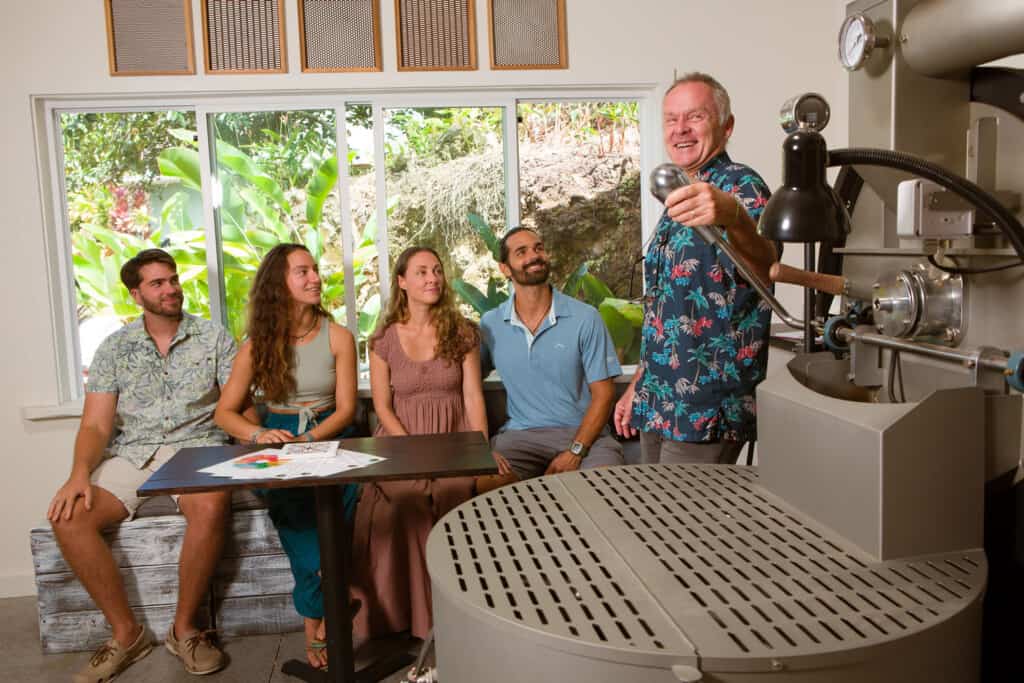
Jean Orlowski of Hala Tree Espresso conducting a farm tour. Courtesy of Hala Tree.
Hala Tree’s SL28 Honey (93) is one other selection related to Kenya that, produced within the context of Kona terroir, is floral, citrusy, cohesive and assured. Hala Tree co-owner Danielle Orlowski says, “Having excessive manufacturing prices pushes us to verify we produce among the best coffees on the planet. That is achieved by taking note of particulars, from farming to processing. Being answerable for the method from tree to cup is what ensures our high quality.”
Kona-born Mark Takizawa has a five-acre farm, Kona Hills Espresso (to not be confused with the large-scale 1,900-acre farm by the identical title), the place he’s carried out every part himself since 1987. His 100% Kona Additional Fancy (92) is a traditional profile with notes of baking chocolate, date and hazelnut.
Hawaiian Roasters That Promote Solely Hawaiian Coffees
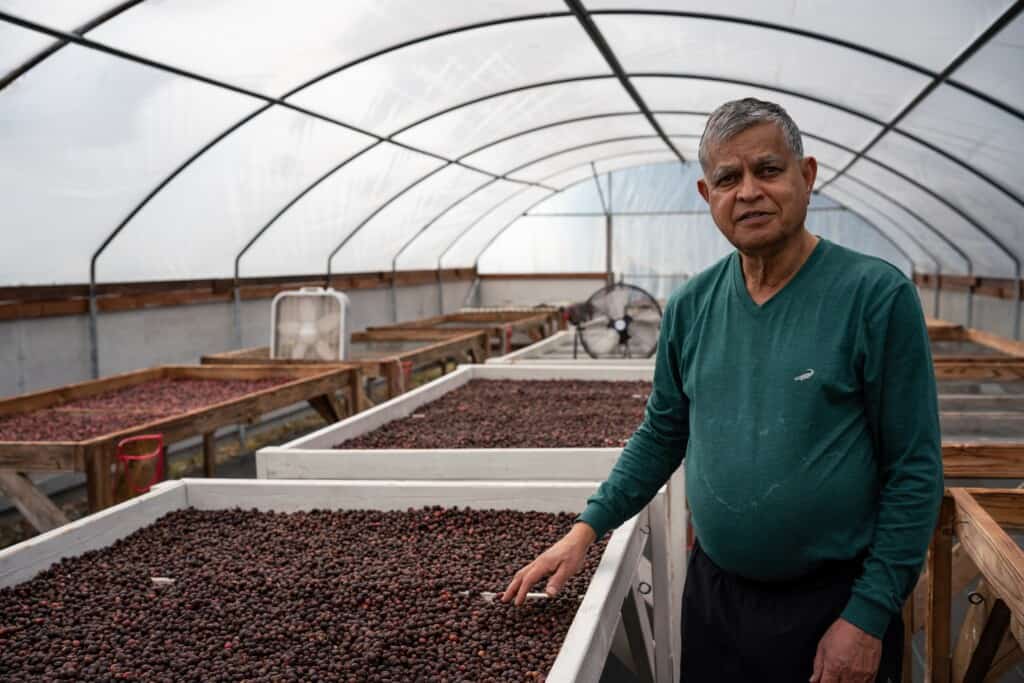
Miles Mayne, of Silver Cloud farm, checking on espresso drying on raised beds. Courtesy of Braden Tavelli.
Huge Island Espresso Roasters despatched in a collaborative espresso in partnership with farmer Miles Mayne. This Ka‘ū Big Maragogipe (95) is the results of co-founder Brandon von Damitz and Mayne’s many yeast experiments over three harvest seasons. The model they landed on makes use of K1-v1116 yeast from Lalvin, with anaerobic fermentation for 72 hours. This uniquely composed, big-beaned Maragogipe cup is pushed by notes of stone fruit, hop-like florals, resiny amber and distinct tangerine. Co-founder Kelleigh Stewart acknowledges the challenges of working completely with Hawaiʻi-grown coffees, but in addition speaks to the alternatives it affords: “When individuals ask, ‘Why is Hawaiʻi espresso so costly?’ this initiates a dialogue for deeper engagement and understanding of the availability chain. There’s a lot extra provide chain transparency and ethics with Hawaiʻi coffees. And the chain is far shorter as a result of there’s little room for center individuals. And a a lot larger proportion of the acquisition value goes on to the farmer. … So, whereas coping with an ‘costly’ product poses challenges, it’s straightforward for us to be happy with our farmer relationships, understanding we’re fostering an moral, clear provide chain. I usually flip the query round and ask individuals, ‘Why is the remainder of the world’s espresso so low cost and undervalued?’”
Pacific Espresso Analysis (PCR) has an fascinating backstory. A women-owned enterprise based as Hawaiʻi’s first training and occasional coaching middle, PCR affords evaluation of inexperienced and roasted coffees, Q-grader programs, barista coaching, tools procurement and upkeep, and rather more. And now, PCR has its personal line of retail-roasted coffees developed in partnership with native farmers with an emphasis on girls producers. The 100% Ka‘ū Navarro (93) submitted for this report, a mix of Pacamara and Catuaí, is from Delvin and Nette Navarro’s Ka‘ū farm. Centered round fruit and floral notes, this mix is sophisticated by a compelling candy herbaceousness. Co-owner Madeleine Longoria Garcia additionally notes the restricted provide of Hawaiian-grown espresso, the impacts of CLR and the 2023 wildfires as important challenges of working completely with Hawaiʻi-grown coffees.
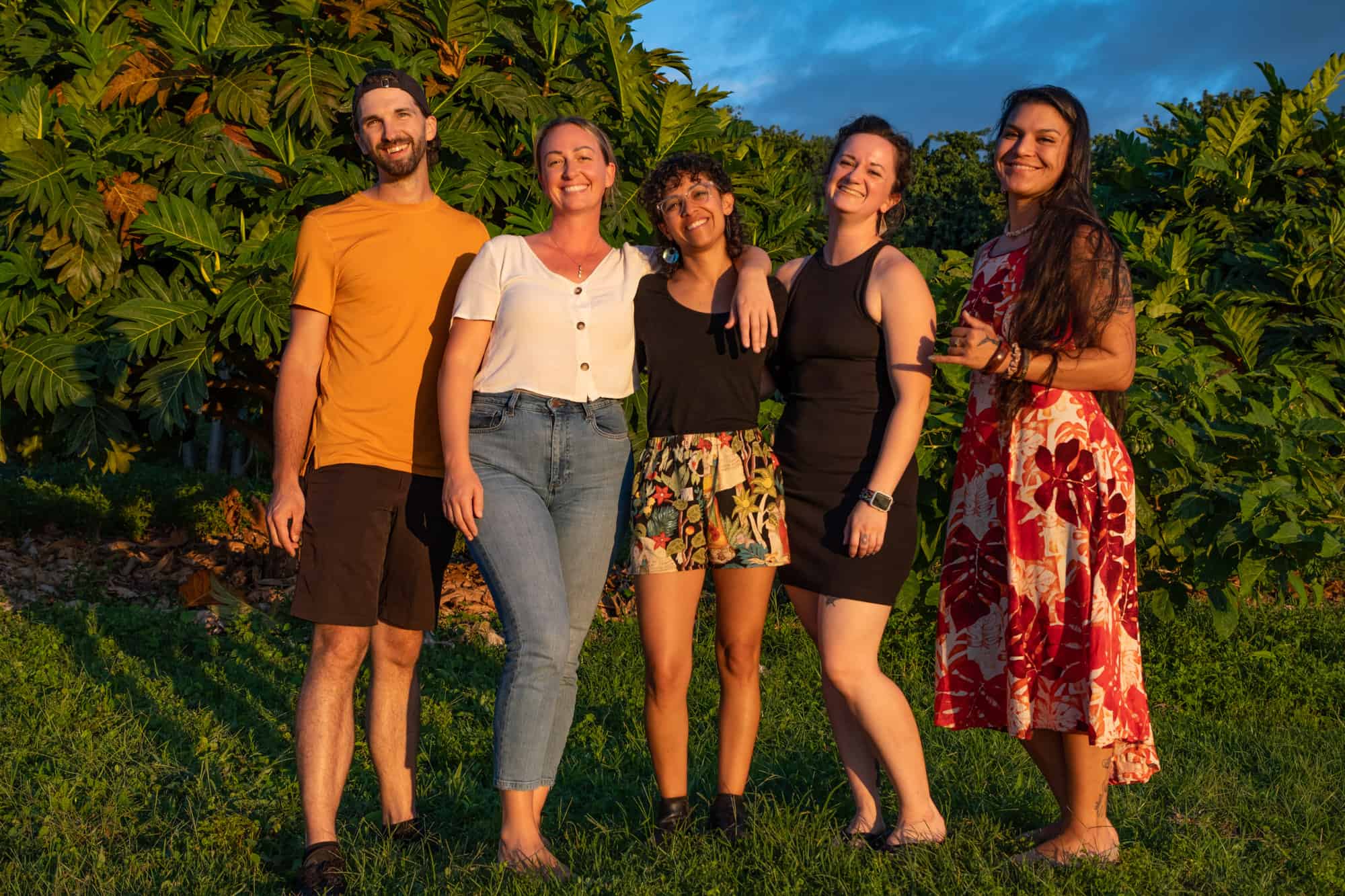
The Pacific Espresso Analysis workforce. Courtesy of PCR.
However as well as, she argues, “The value mannequin utilized in Hawaiʻi ought to be replicated globally. In an effort to have financially sustainable companies, growers want to have the ability to promote their merchandise based mostly on their actual prices and required revenue margins versus having their merchandise’ value being dictated based mostly on the place the C-market occurs to land on any given day. Our international trade talks about this on a regular basis, as we don’t have a financially sustainable trade, and nobody is actually doing very a lot to alter that. The present mannequin offers consumers an excessive amount of energy with regards to value and strips growers of negotiation energy as a result of everyone seems to be wanting on the C-market.”
Hawaiian Roasters That Promote Each Native and World Coffees
Little-known reality: It’s unlawful for roasters in Hawaiʻi to import inexperienced coffees from Africa. This outdated legislation hearkens again to issues about agricultural contamination, but it surely’s nonetheless on the books, and it’s why you’ll see coffees from Central and South America and Indonesia at native island espresso outlets — however not African coffees.
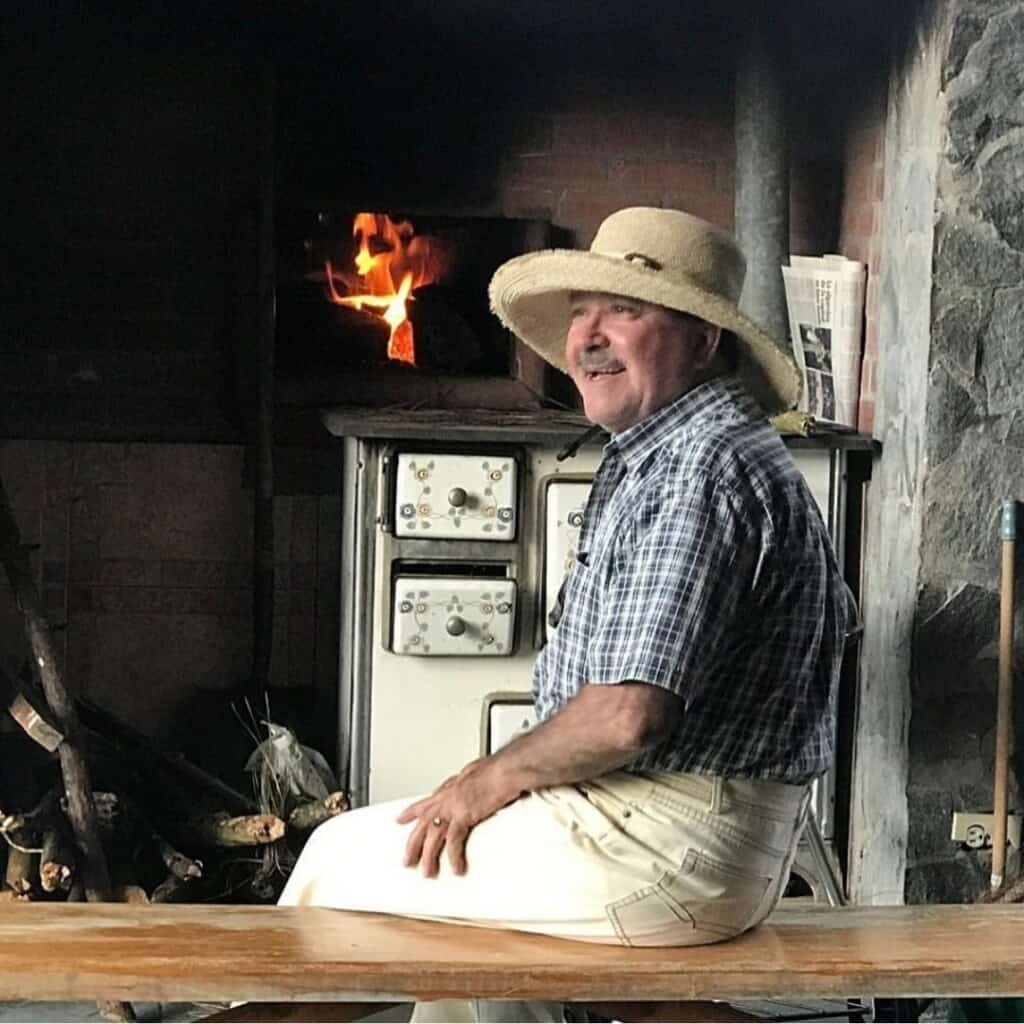
Teodoro Garrido, founding father of Mama Cata Farm in Boquete, Panama. Courtesy of Klatch Espresso.
Nicely-known to the digital pages of Espresso Overview, Hilo-based Paradise Roasters used to have a roasting facility in Minnesota. Now that the corporate is totally Hawaiʻi-based, proprietor Miguel Meza focuses on uncommon microlots from the Philippines, Thailand, Vietnam, Panama and, in fact, Hawaiʻi. For this report, we overview the richly floral, fruit-saturated Panama Mokkita Pure Mama Cata Property (96) with notes of untamed strawberry, lavender and black sage. Meza says, “We didn’t begin out as a roaster of Hawaiʻi-grown coffees, however slightly as a specialty espresso roaster. As a result of extraordinarily excessive price of manufacturing espresso in Hawaiʻi, 10 instances that of most different international locations, the marketplace for Hawaiʻi-grown coffees is proscribed as a daily-drinking espresso for many shoppers. Furthermore, we like selection and need to provide the widest array of sensory experiences doable with espresso, a few of which can not (but) be discovered inside espresso simply from Hawaiʻi.” He provides that, “Like each different producing origin, nearly all of the coffees produced in Hawaiʻi are business high quality, not specialty. As a really small producing area, the portions of high-quality espresso from Hawaiʻi are fairly restricted. A lot of our Hawaiʻi coffees we produce from the cherry stage to make sure high quality and apply proprietary processing methods on them to create a range of cup profiles.”
Maui-based Origin Espresso Roasters submitted a JN Farms Double Anaerobic Pink Bourbon (94) produced in Ka‘ū, an aromatically wide-ranging cup with notes of spice-toned florals and sweetly tart fruits. Proprietor Heather Brisson-Lutz loves Hawaiʻi-grown coffees however finds that she must additionally present coffees from different origins for her native buyer base: “It’s difficult to market coffees not grown in Hawaiʻi in our native markets, however we’ve got discovered that most of the native residents get pleasure from these coffees as a result of they provide totally different flavors, and their value factors are friendlier for each day espresso drinkers. We need to preserve our coffees accessible not solely in value level but in addition when it comes to taste profiles, processing strategies and varieties.”
Kailua, O’ahu-based ChadLou’s Espresso Roasters sells each Hawaiʻi-grown and worldwide coffees. The Cruz Loma Anaerobic Washed Ecuador (93) we overview right here is equal elements candy, tart and savory (assume darkish chocolate, macerated kiwi and tarragon). Its widespread espresso store caters to each guests and locals, providing a big menu of specialty espresso choices in addition to artfully designed luggage to take house.
Hanalei Espresso Roasters is a micro-roaster on Kauaʻi’s North Shore within the stunningly stunning city of Hanalei. Its Dawn Mix (92) of coffees from Maui and Honduras is a pleasant, easygoing and reasonably priced espresso with notes of golden raisin, cashew, orange zest and cane sugar. The roaster has a choice of 100% Hawaiian coffees along with its coffees from Central and South America.
Maui Oma Espresso Roasting Co.’s 100% Hawaii Three Island Mix (92) is a mixture of coffees grown on Hawaiʻi Island, Maui and O’ahu. Cocoa-toned and richly nutty, it’s a superb introduction to the coffees of the Hawaiian Islands for newcomers to the style. Maui Oma is situated in Kahului, Maui, and primarily works with Hawaiian coffees but in addition has a choice of coffees from Central and South America and Indonesia.
Supporting the Hawaiʻi Espresso Trade
No matter your espresso jam is perhaps, Hawaiian roasters provide the world in a cup. Along with shopping for espresso instantly from the roasters featured on this report, you’ll be able to help Maui’s wildfire restoration efforts right here:
MauiGrown Espresso – Go Fund Me
Maui Meals Financial institution

